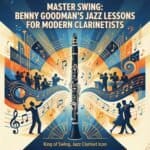What is a swing clarinet? A swing clarinet is a clarinet played in the rhythmic, melodic and tonal style of Swing Era jazz, centered on the 1930s and 1940s.
- Era: 1930s-1940s big band and small group jazz
- Signature sound: clear tone, swift vibrato, precise articulation, long-phrase breath control
- Canonical example: Benny Goodman's 1935 Palomar Ballroom performance
The Clarinet's Role in the Swing Era – an overview
During the Swing Era, the clarinet moved from dance band sideman to front-line star. In the hands of players like Benny Goodman and Artie Shaw, it became a lead voice that could cut through big band brass, sing lyrical ballads, and drive high-energy solos. Its agility and wide range made it ideal for intricate riffs and call-and-response writing.
Clarinetists shaped the sound of swing by combining classical-level technique with blues phrasing and jazz rhythm. They used clean attacks, fast but controlled vibrato, and long, arching phrases that rode over a steady 4-beat pulse. For intermediate players today, understanding this role provides a roadmap for phrasing, tone concept, and how to sit in front of a rhythm section.
Historically, the clarinet bridged older New Orleans and Chicago styles with modern big band arranging. In small groups, it often replaced the trumpet as the main melodic instrument. In large ensembles, it could both blend with the saxophone section and step out for virtuosic features, making it central to the public sound image of swing.
Timeline: Early Swing to Late Swing (1920s -> 1950s) with key dates
Clarinet's swing story starts before the classic Swing Era. In the 1920s, New Orleans and Chicago players like Johnny Dodds and Jimmie Noone developed fluid, singing clarinet lines over early jazz rhythms. Their recordings for labels in Chicago and New York laid the technical and melodic groundwork that later swing clarinetists studied and adapted.
In 1909, Benny Goodman was born in Chicago, a city that would become important for jazz and swing. By the late 1920s he was already recording as a sideman. The early 1930s saw dance bands shift toward smoother, riff-based writing, with clarinet often doubling saxophone parts. Radio broadcasts spread this sound across the United States, preparing audiences for a clarinet-led swing explosion.
The turning point for swing clarinet came on August 21, 1935, when the Benny Goodman Orchestra played the Palomar Ballroom in Los Angeles. Their hotter, riff-driven arrangements ignited the crowd and are often cited by historians as the start of the national Swing Era. Goodman's bright, focused clarinet sound became a template for bandleaders and students alike.
From 1935 to 1945, swing clarinet flourished. Goodman, Artie Shaw, Woody Herman and others recorded prolifically. After 1945, bebop and smaller combos shifted the spotlight to saxophone and trumpet. Clarinetists like Buddy DeFranco adapted to bebop, but the big band swing clarinet sound gradually moved from pop culture center to a more specialized jazz tradition through the 1950s.
Pivotal Figures: Benny Goodman, Artie Shaw and landmark performances (Goodman 1909 birth; Palomar Ballroom 1935)
Benny Goodman, born in 1909 in Chicago, is often called the “King of Swing.” His classical training, precise technique, and strong rhythmic drive defined swing clarinet for a generation. Recordings such as “Sing, Sing, Sing” and “Stompin' at the Savoy” show his ability to project a clear, ringing tone over a roaring big band.
The 1935 Palomar Ballroom engagement in Los Angeles marked a historic moment. Goodman's band, initially struggling on tour, switched to their hotter arrangements heard on late-night radio. The crowd response was explosive, and news accounts describe dancers demanding encore after encore. This performance cemented clarinet as a lead symbol of swing in the public imagination.
Artie Shaw offered a contrasting model. His tone was slightly darker, with a smoother, more legato approach. Recordings like “Begin the Beguine” and “Stardust” highlight his lyrical phrasing and sophisticated harmonic sense. Shaw's playing showed that swing clarinet could be both virtuosic and introspective, influencing later modern jazz clarinetists.
Other important figures include Woody Herman, whose early bands featured his own clarinet alongside strong saxophone sections, and small-group players like Edmond Hall and Pee Wee Russell, who kept a more traditional yet rhythmically modern clarinet style alive. Together, these artists created a diverse but recognizable family of swing clarinet sounds.
Signature Swing-Era Techniques: vibrato, articulation, breath control, alternate fingerings, improvisation
Swing clarinet vibrato is usually faster and narrower than classical vibrato. Players like Goodman used a jaw-based vibrato that activates late in the note, especially on sustained tones. Aim for a subtle shimmer rather than a wide wobble. Practice holding a note straight for two beats, then adding gentle, quick vibrato for the last two beats.
Articulation in swing is crisp but not harsh. Many solos use a mix of light “doo” and “dah” syllables, with occasional accented “ta” for emphasis. The tongue touches just behind the tip of the reed, not too far back. Practice alternating slurred and lightly tongued eighth-note lines over a metronome set to a walking 4-beat, focusing on even swing feel.
Breath control is important for the long phrases heard in Goodman and Shaw solos. Swing clarinetists often play 8 to 16-bar lines without obvious breaks. This requires efficient air use, relaxed throat, and planning phrase peaks. Work on slow, full-breath long tones, then apply that support to transcribed swing phrases, minimizing unnecessary tongue or jaw movement.
Alternate fingerings help smooth fast passages and keep intonation stable. For example, using side keys or different throat-tone combinations can make chromatic runs cleaner at swing tempos. Study common alternate fingerings for notes like B-flat, F-sharp, and throat tones, then practice them in scale patterns at gradually increasing speeds to match historical recordings.
Improvisation in swing clarinet blends arpeggios, chord tones, and blues inflections with clear melodic shapes. Transcribing solos by Goodman or Shaw reveals frequent use of enclosure patterns, chromatic approach notes, and call-and-response motifs. Practice improvising over 12-bar blues and rhythm changes using simple motifs, then gradually add chromaticism while keeping a strong, singing melodic line.
Instrument Anatomy & How Mouthpiece, Reed and Setup Shape Swing Tone
Swing clarinet tone depends heavily on mouthpiece design. Historical swing players often used medium tip openings with moderate facings, which balance flexibility and projection. For modern equipment, a tip opening in the range of about 1.05 to 1.15 mm with a medium facing length is a good starting point for achieving a clear yet warm swing sound.
Reed strength influences response and color. Many swing-oriented players prefer medium-soft reeds, around 2.5 to 3.0 on common strength scales, to allow quick articulation and easy altissimo access. Harder reeds can give more core and projection but may slow articulation and make vibrato less agile. Test reeds in half-strength steps and record yourself at performance volume.
Barrel length and bore shape affect focus and intonation. A slightly shorter barrel can brighten tone and raise pitch, which may help cut through a big band. Cylindrical vs slightly polycylindrical bores respond differently in the upper register. Experiment with one or two alternate barrels a few millimeters shorter or longer to find a sweet spot for swing phrasing and tuning.
Keywork and ergonomics also matter. Smooth, well-aligned keys allow clean alternate fingerings and fast runs. Check that side keys and pinky keys respond evenly so that chromatic passages feel predictable. Swing clarinet solos often live in the clarion and altissimo registers, so comfortable right-hand position and stable thumb support are important for accuracy at higher tempos.
Alternate fingerings interact with instrument design. For example, some clarinets favor the long B-flat fingering for better intonation, while others respond better to the side-key B-flat in fast passages. Test each alternate fingering with a tuner and in short swing phrases at different dynamics. Choose the options that tune well and speak reliably at your target tempo.
Clarinet in Big Bands: solo vs. section roles and arranging considerations
In big bands, clarinet often serves a dual role. As a solo instrument, it steps in front of the ensemble for featured choruses, often after sax or brass sections. As a section instrument, it may double lead alto sax an octave above, add color lines, or form a clarinet-led reed section in specialty arrangements, especially in Benny Goodman-style charts.
Arrangers in the Swing Era used clarinet to create contrast. A brassy shout chorus might be followed by a lighter clarinet solo or soli passage. Clarinet could also introduce or restate themes in a higher register, giving the ear a fresh color. When writing or reading swing charts today, look for these contrast points and plan your dynamics and tone color accordingly.
Section roles varied by band. In some orchestras, clarinetists doubled on saxophone and only switched to clarinet for specific passages. In others, clarinet stayed as a primary voice. Understanding your chair expectations is important. Practice fast switches between instruments if doubling, and maintain a consistent swing articulation concept whether you are in the section or soloing.
Balance and projection are key arranging considerations. Clarinet must be heard clearly without overpowering the band. Use a centered, focused tone with enough edge to project, but avoid overblowing, which can thin the sound. Coordinate with brass and sax sections in rehearsal to find dynamic levels where clarinet lines speak clearly in ensemble textures.
The Swing Revival: late 20th-century resurgence and modern interpretations
From the 1970s onward, a swing revival brought clarinet back into focus. Traditional jazz and swing bands in the United States and Europe revisited Goodman and Shaw repertoire. Organizations like Jazz at Lincoln Center highlighted big band literature, and clarinetists began to study original recordings alongside modern jazz methods, blending historical style with contemporary technique.
The 1990s saw another wave of interest through neo-swing and dance-oriented bands. While many of these groups featured saxophones and guitars, clarinet appeared as a nostalgic color and solo voice. Some players adopted a more aggressive, amplified sound, while others stayed close to 1930s tone ideals, showing that swing clarinet can adapt to new contexts without losing its core identity.
Modern clarinetists often take a historically informed approach. They analyze archival recordings, read period reviews, and compare equipment designs. Many combine swing phrasing with post-bop harmonic vocabulary, creating a hybrid style. For students, this revival provides a rich set of models: classic Goodman or Shaw, traditional revivalists, and contemporary jazz clarinetists who reference swing while exploring new directions.
Practice Routines & Workshop Notes: exercises for long phrases, tongue placement, articulation drills
To build swing clarinet breath control, start with long-tone exercises. Play each note from low E to high C for 12 to 16 counts at a moderate dynamic, focusing on steady pitch and relaxed throat. Then apply the same air support to 4-bar and 8-bar phrases from transcribed swing solos, aiming to complete each phrase in a single breath.
For tongue placement, practice a simple G major scale in eighth notes at 80 bpm, alternating between fully slurred and lightly tongued patterns. Use the syllable “doo” for most notes and “da” on occasional accents. Gradually increase tempo to 140-160 bpm while keeping the tongue motion minimal and close to the reed tip.
Articulation drills should include swing eighth-note patterns. Take a two-bar riff, such as a simple arpeggio pattern, and play it with different tongue patterns: all slurred, every note tongued, and mixed (slur two, tongue two). Record yourself to check for consistent swing feel and clarity. Aim for a light, bouncing attack rather than a heavy, staccato style.
For long phrases in the Goodman style, choose an 8-bar solo segment and break it into 2-bar chunks. Practice each chunk slowly, focusing on finger coordination and air support. Then connect the chunks, reducing or eliminating breaths between them. Use a metronome to gradually approach original recording tempo while maintaining relaxed embouchure and smooth finger motion.
Alternate fingering practice is also important. Create short technical patterns that specifically use alternate B-flat, F-sharp, and throat-tone fingerings. Practice these patterns in all keys at moderate tempos, then insert them into swing etudes or transcribed lines. This builds automatic responses so that in performance you can choose the fingering that best supports tone and intonation.
Maintenance & Troubleshooting for Swing Players (basic care, reed/mouthpiece selection, common problems)
Consistent swing clarinet tone depends on regular maintenance. Swab the instrument after every session to remove moisture, paying special attention to the upper joint where condensation collects. Apply cork grease lightly to tenon corks once or twice per week, or whenever assembly feels tight, to avoid twisting stress that can misalign keys and affect response.
Reed care is important. Rotate 3 to 4 reeds in active use, storing them in a ventilated reed case. For typical practice loads of 1 to 2 hours per day, expect to replace reeds every 2 to 4 weeks, depending on your embouchure and moisture. Slight warping or chips can introduce squeaks and unstable pitch, especially noticeable in swing's exposed high-register lines.
Inspect pads and keys monthly. Look for dark rings or frayed edges on pads, which can cause leaks and weak response. Check that spring tension feels even across the instrument. Leaks in the upper joint often show up as unreliable throat tones or difficulty starting notes cleanly, which can disrupt fast swing articulations and long phrases.
Common troubleshooting starts with squeaks. These often result from too much pressure on the reed, a damaged reed tip, or an embouchure that pinches. Test with a fresh reed of the same strength, then one half-strength softer or harder. If squeaks persist, relax your jaw, roll in slightly less lower lip, and check that the reed is centered and aligned on the mouthpiece.
Intonation issues can be addressed by small mouthpiece pulls or pushes, reed choice, and alternate fingerings. If upper-register notes run sharp, try a slightly softer reed or a marginally longer barrel. For flat low notes, increase air support and experiment with alternate fingerings where available. Always compare your setup against a tuner and a reference swing recording to keep your ear calibrated.
Key Takeaways
- Swing clarinet centers on a clear, projecting tone, fast but controlled vibrato, precise articulation, and strong breath control for long phrases modeled on players like Benny Goodman and Artie Shaw.
- Equipment choices, especially mouthpiece tip opening, reed strength, and barrel length, strongly influence swing tone, response, and projection in both big band and small-group settings.
- Focused practice on long tones, tongue placement, alternate fingerings, and historically informed phrasing, combined with consistent maintenance and reed rotation, helps modern players recreate authentic Swing Era clarinet sound.
FAQ
What is swing clarinet?
Swing clarinet refers to clarinet playing in the style of the Swing Era, roughly the 1930s and 1940s. It features a clear, focused tone, rhythmic swing feel, fast but subtle vibrato, and long, lyrical phrases, often heard in big bands and small jazz groups led by players like Benny Goodman and Artie Shaw.
How did the clarinet shape the Swing Era (1930s-1940s)?
The clarinet became a signature voice of the Swing Era through bandleaders such as Benny Goodman and Artie Shaw. Its agile range and bright tone cut through big bands, defined melodic themes, and delivered virtuosic solos. Landmark performances like Goodman's 1935 Palomar Ballroom engagement helped launch swing as a national craze.
What techniques define swing-era clarinet playing?
Key swing clarinet techniques include narrow, quick vibrato applied late in sustained notes, light and precise articulation using “doo” and “da” syllables, strong breath support for long phrases, strategic use of alternate fingerings for smooth runs, and melodic improvisation that blends chord tones, blues inflections, and clear rhythmic phrasing.
How can I practice breath control to play long phrases like Benny Goodman?
Start with long tones of 12 to 16 counts on each note, focusing on steady air and relaxed throat. Then practice 4-bar and 8-bar phrases from Goodman solos at slow tempos, aiming to play each in one breath. Gradually increase tempo while keeping the sound even and avoiding extra tension in the jaw or shoulders.
What reeds and mouthpiece choices help achieve an authentic swing tone?
A medium tip opening mouthpiece, roughly 1.05 to 1.15 mm, paired with medium-soft reeds in the 2.5 to 3.0 range, is a good starting point for swing. This setup supports quick articulation, responsive altissimo, and a clear yet warm tone. Experiment within this range and record yourself to find the combination that projects well and feels comfortable.
Where can I find primary sources or recordings from the Swing Era?
Look for original Benny Goodman and Artie Shaw recordings in archives such as the Library of Congress and collections associated with Jazz at Lincoln Center. Many classic performances, including the 1935 Palomar Ballroom broadcast material and 1938 Carnegie Hall concert, are available in remastered audio and video releases with documented dates and personnel.






